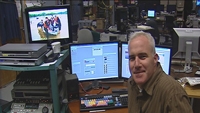Nashville CBS affiliate rises from the flood

When the terrible flooding that hit Nashville this past spring hit left the newsroom at local CBS affiliate WTVF-TV under 4in of water, the station was forced to rethink how it produced its news in order to get back on the air as quickly as possible. Since that May disaster, the station is slowly making a Phoenix-like recovery and installing a variety of file-based HD production tools that will be fully operational and on-air when rebuilding of the newsroom is complete by the end of the year.
Owned by Landmark/Dominion Enterprises, the station’s control rooms and news studios, located on a second floor, were not damaged during the flood and continue to operate normally. The entire news staff, however, had to find new homes on higher floors within the station’s building. Editors are now located in a cramped loading dock. Producers currently work from a former training room and closets.
WTVF viewed the flood as an opportunity and quickly began designing a newsroom that would create an open, more collaborative environment that leveraged the latest newsroom technologies, workflows and computer upgrades.
Rather than surrendering to defeat, WTVF saw an opportunity to rebuild its news production processes from scratch and leverage the latest technology to streamline operations.
“You don’t get this type of green field opportunity very often in this business, so we turned a negative situation into a positive one for our staff,” said Mike Rose, chief news photographer at WTVF. “It is a lofty goal, but one that we feel we can accomplish with the right planning and file-based technology.”
To accomplish its lofty goal, WTVF invested in digital news production technology from Avid. When complete, it will include 18 Avid NewsCutter (version 9) and two Media Composer (version 5) editing workstations for the news department (and onboard its five ENG mobile production vans), an ISIS shared storage (64TB system) that will be shared by every department, a full suite of Interplay software tools for sharing assets, an iNEWS newsroom computer system, iNEWS Instinct for searching and retrieving clips off the ISIS server, two AirSpeed MultiStream video servers (eight channels of HD in and out) and a Pro Tools audio system for audio editing and sound effects creation.
Nine of the NewsCutter systems will feature Avid’s Mojo DX hardware to handle video as a baseband signal for live ingest of breaking news and shared pool feeds. The Avid Instinct software will allow reporters and producers to evaluate clips and make rough cuts of news packages before they go to an editor at the station for finishing.
Get the TV Tech Newsletter
The professional video industry's #1 source for news, trends and product and tech information. Sign up below.
In 2007, the station became the first in its market to broadcast its local news in HD, which necessitated the installation of new studios and control rooms. Field ENG was captured in the 16:9 aspect ratio with standard-definition Sony Betacam SX cameras and upconverted to match studio images for the daily newscast. Editing was accomplished from videotape (which continues today).
At that time the station’s production and investigative departments upgraded to three Sony XDCAM HD cameras and five Avid Media Composer systems — which were not networked together and used across all of the departments. More than half of the station’s 21 news photographers use the Avid systems at one time or another in the news cycle. (It was the editing interface familiarity, the wide range of tool sets, tight integration with the iNEWS system, and an attractive support program that led the station to stay with Avid. Rose said training the staff should be minimal.
“The new workflow will definitely change the way we create news, but it will also be a huge advantage for our news staff,” Rose said. “Currently, when a feed comes into the station, our editors have to stop working, eject the tape they are working with, load in a record tape, dub it back over to another tape for someone else to begin working. It’s a very time-consuming process, especially when you have multiple feeds coming in, sometimes simultaneously.”
Newscasts are currently archived on 90-minute Betacam SX tapes, stacked on a shelf in a dedicated room. Going forward, WTVF will implement a media asset management system and eventually archive on a LTO-5 data tape library.
Once the new equipment is implemented, rather than having to track down a physical tape, the staff will have access to a central ingest repository where engineers can tune in live shots and also have access to the HD channels on the AirSpeed servers. This way multiple users can begin working immediately after a clip has been downloaded — or in some cases before the clip has finished. Clips will also be simultaneously stored on the ISIS system and be available to everyone at the station.
“The new newsroom will make our station much more competitive in our market because we’ll be able to turn around packages much faster than we ever could before,” Rose said. “We’ll also be able to create news with less steps involved and the content will touch fewer hands, which will eliminate errors. I see a lot of good coming from what was a very challenging situation.”
